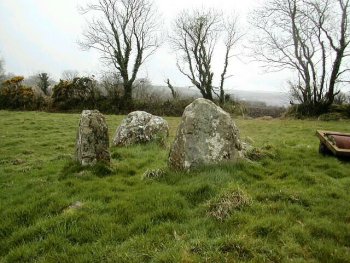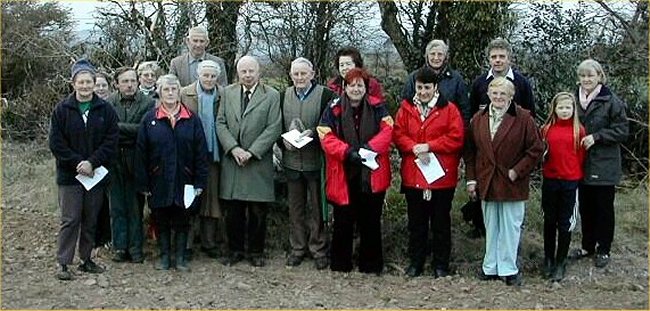Canovee Historical
&
Archaeological Society.
Officers 2003-2004
President: Rev. Fr. T. O'Sullivan
Vice-President: Dan Looney
Chairperson: Nora O'Leary
Vice Chairperson: Peter Scanlan
Hon Secretary: Jim Crowley
Assist. Secretary: Mary O'Sullivan
Hon. Treasurer: Sheila Hurley.
|
PROGRAMME
2005 - 2006
15th
of September
Annual
General Meeting.
***********
12th
of October "Landlord and tenant farmer"
by Michael Galvin
***********
9th
of November "Folklore Night"
local customs and traditions
***********
8th
of Feb. "The Brehon Laws"
By Kenneth Nicholls
***********
8th
of March "History of Crookstown Village"
By Henry Wall
***********
12th
of April "Local emigrants to America in the 1800s"
By Nora O'Leary.
***********
10th
of May Field outing to Cnoc An Tobair.
***********
14th
of June Annual Outing
***********
|
Canovee
Historical &
Archaeological Society.
The Canovee Historical and Archaeological Society,
founded in 1981 and a registered member of the Federation
of Local History Societies, meets on the second Thursday of
the month from September to April at Canovee Hall. Generally
a guest speaker is invited to give a talk/lecture on local
history, folklore or archaeology.
In the summer time members usually have a field outing, sometimes
in company with one of the other local societies and visit
one of the many interesting sites of historic importance in
the district.
Canovee also organise an annual excursion, before the harvest
time during the month of July when John and Bridie Sheehan
very kindly act as guests.
Top of Page
|
Top of Page
|
Canovee
Historical and Archaeological Society
Field Trip To Upper Bellmount
Thurs. 11th of April 2002. By kind
permission of Denis & Mary Murphy,
Mary Lynch, Brendan & Margaret Hayes
~~~~~~~~~~~~~~~~~~~~~~~~~~~~~~~~~~~~~~~~
The group met at Crookstown Hall
at 7:30 and first stop was a Stone Circle in Upper Bellmount.
The following account is take from a talk given by Peter
Scanlan on the night
Bellmount Upper 721 acres
This townland was appropriated by the Baldwins of Mount
Pleasant who
took patent for it in the time of King James I. In this
they had the
privilege of four fairs in the year,17th of March, Corpus
Christy,
21st of September and the 8th of November.
Top of Page
Please scroll down this page for more information and
photos
Stone
Circles
|
|
|
In Kilmurry parish there are six known Stone
Circles, two in the
townland of Knockavullig, two in the townland of Upper
Bellmount
and two in the townland of Currabeha. Four of the
circles are what
is known as "Five Stone Circles", the two
in Currabeha are multipliable
stone circles.
|

Stone Circle Number 1 Upper Bellmount
|
| |

Stone Circle Number 2 Upper Bellmount.
(Part of this circle is missing)
Top of Page
|
This
Stone Circle is a good example of its kind to be found
in this area, it has all the features of a five stone
circle. Stone Circles consist of a ring of free standing
stones, in this case five stones, uneven in number and
symmetrically arranged so that one stone, the axial stone,
is set directly opposite two stones, usually the tallest,
marking the entrance to the circle. Characteristically,
the stones reduce in height to the axial stone, which
is set consistently in the south-western part of the monument
with a common basic design. Though cremated burials in
small unmarked pits were discovered at some circles, such
as at Drombeg in West Cork, This multipliable stone circle
at Drombeg was excavated, by Dr Fahy and published in
C.H.A.S. Journal in 1950. |
|
These monuments are not primarily burial burial places
but are generally
regarded as ritual sites where ceremonies took place.
Many stone
circles appear to have been deliberately orientated
so that the main
axis of the circle (a line extending from the middle
of the gap between
the entrance stones across to the centre of the axial
stone ) is
aligned north-east/south-west - ( This circle is aligned
NNE-SSW)
those sectors of the horizon in which the sun rises
or sets at significant
times during the year, an equinox or a solstice. For
example at
Drombeg, during the midwinter solstice, the sun appears
to set at
a point on the horizon in line with the axis of the
stone circle.
In Ireland stone circles are concentrated in mid-Ulster
and in South
Kerry/West Cork, as are stone rows. Exact dating evidence
is lacking,
but they are likely to be Bronze age in date, which
would date them
to about three and a half or four thousand years old.
|
|
Group Photo taken at a Stone Circle
in Upper Bellmount
|

Top of Page
|
| |
The Group then paid a brief visit
to a Ringfort
Ringforts are the most widespread field monument to
be found in
the Irish countryside. Excavation has shown that the
majority of ringforts
were enclosed farmsteads, built in Early Christian times.
The earth
works acted as a defense against natural predators,
like wolves, as
well as human predators. Local warfare and cattle raiding
were common
place at that time. As well as farming related activities,
the ringfort
was home to a wide variety of craft industries, including
spinning,
weaving, metal and glass working. Dwellings and outhouses
were built
of timber posts, with walls of wattle mud and sods,
which usually
leave no trace above ground today. There are three ringforts
in Upper Bellmount

One of the three Ringforts in Upper Bellmount
|
| |
Next stop was Commons Holy Well
in the farm of Brendan & Margaret
Hayes.
Commons (meaning Coimin, Commonage.)
This well was known as Tobernafoora which means Tobar
na Fuaire,
The Well of Cold Sting. When the Archaeological Survey
Team visited
the site on 29th of March 1994, they recorded "That
the well is situated
in east facing pasture, now infilled since about 1988.
Nothing remains
of it" They quoted Mrs. Hayes (ne Long) as saying
rounds were made
here until about 1957. The rounds were made at the well
during Holy
Week - at Easter time over a few days, and that money
would be left
at a rock in the field to the east of the well, this
was also part
of the round. This rock was removed during land reclamation
and another stone put there to mark the site. At one
time a stone slab covered the well. There is a tradition
that water from this well would never boil. There was
also another well close bye called called,
The Well of the Goddess.
Top of Page
|
|
|